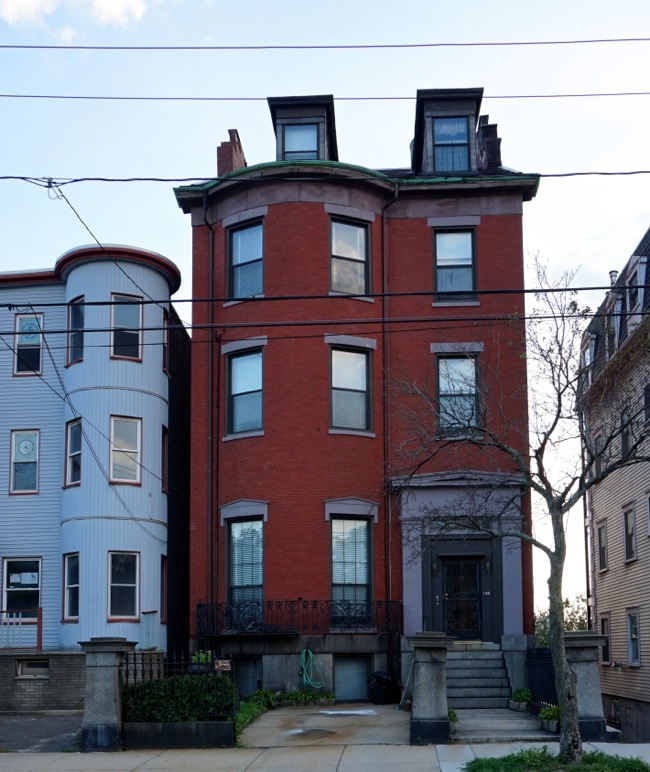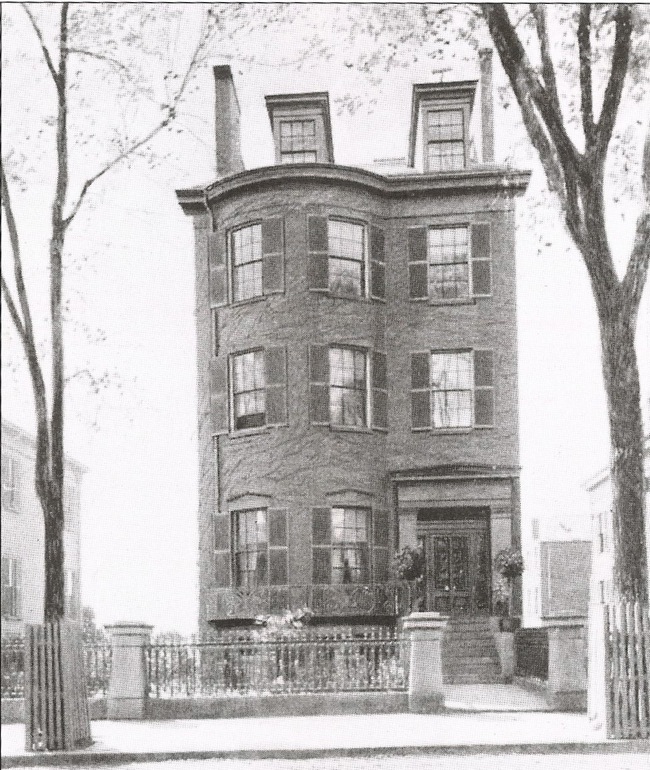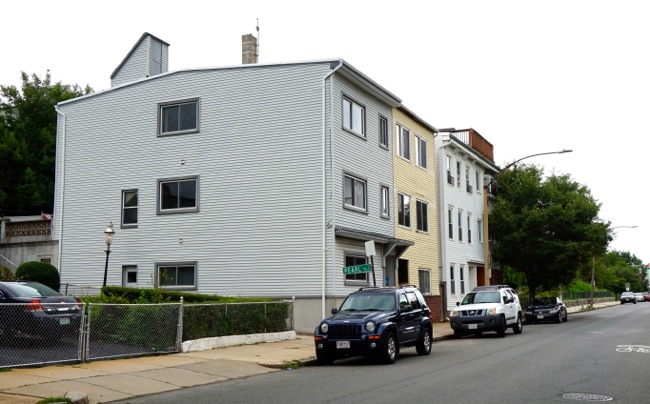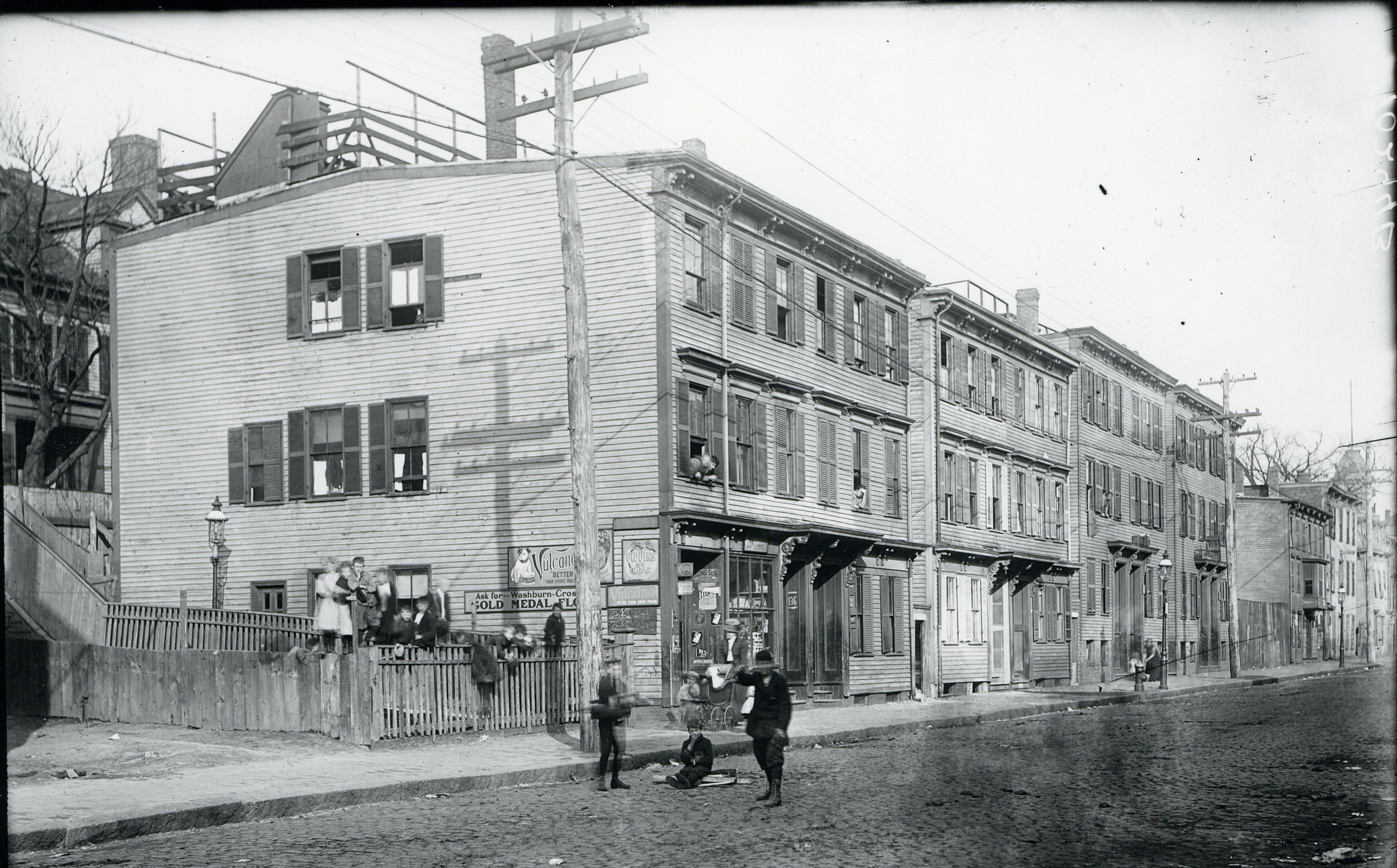This post is part of a series about the process of nominating my neighborhood for the National Register of Historic Places. To see all of the posts in the series, click here.
Old photos might be the closest thing we have to a time machine. They offer a glimpse of the past, but they don’t provide any context. As I’ve worked to nominate part of the Jeffries Point neighborhood for the National Register of Historic Places over the past few months, I’ve turned to old photos over and over again to try to understand how the neighborhood has changed over time. But each photo is like a single puzzle piece, often creating more questions than it answers. As I’ve talked to longtime residents and sifted through other sources – books, maps, newspapers – I’ve gradually come to understand the stories behind some of these old neighborhood photos. I’ve put together a series of Then-and-Now pictures of the neighborhood, comparing old photos with present-day versions taken from the same location, along with the story each photo tells about the neighborhood’s past. Today, let’s take a look at how the Samuel Hall House and Marginal Street have changed over the years. Use the slider in the center of each picture to compare past and present. Stay tuned for more then-and-now photos of the neighborhood in a later post.
The Samuel Hall House


Left: 2017 | Right: before 1895
Samuel Hall was the first shipbuilder to move to East Boston. A self-made man, he started his career as a shipwright with only “a broad-axe and twenty-five cents” to his name. He went on to become a world renowned shipbuilder, an alderman on the Boston City Council, and one of Boston’s most prominent citizens.
Hall opened a shipyard along East Boston’s western waterfront in 1839, at the age of 40. At the time, the neighborhood of East Boston was just six years old. With a population of about 1000, it more closely resembled the sleepy harbor island it had been for the past 200 years than the bustling urban neighborhood it would soon become. During the 1840s, Hall built a reputation as a master-builder of fast, reliable sailing ships for New England merchants. His success attracted other shipbuilders to the young neighborhood, most famously Donald McKay, who moved to East Boston in 1845. In 1850, Hall launched the Surprise, Massachusetts’s first clipper ship. The Surprise brought Hall international fame – it went on to work in the China trade, and was one of the most profitable and fastest ships to ever sail that route, making eleven consecutive passages from China to New York – over 14,000 miles – each in less than 89 days.
Over the next decade, heavy demand for clipper ships kept Hall and the rest of East Boston’s shipbuilders busy. During this time more clipper ships were launched from East Boston than from all the shipyards in New York, Baltimore, Philadelphia, or London. Thousands of sail makers, carpenters, caulkers and other artisans moved to the neighborhood to work in the booming shipbuilding industry – between 1840 and 1865, East Boston’s population grew from 1,455 to 20,572. Hundreds of new houses were built to accommodate this population explosion, and in just a few short years, the neighborhood was transformed. By 1870, East Boston had become a place that many present-day residents would recognize – a busy urban center and transportation hub. And it was all thanks to the shipbuilding industry that Hall had founded.
Samuel Hall bought the stately townhouse pictured here in 1853 at the height of his success. Although most of East Boston’s shipbuilders chose to live as close to their shipyards as possible, Hall’s house was almost a mile from his shipyard. The house’s prime location at the top of the hill in Jeffries Point presumably made up for the extended commute. The rear of the house faces the waterfront, with expansive views of the harbor and downtown Boston beyond, while the front of the house overlooks Belmont Square. In 1853, the same year that Hall bought the house, the city added an iron fence and landscaping to the square. This may not have been a coincidence. Hall was well connected – he had been an alderman on the Boston City Council just a few years earlier.
Little has changed in the 120-plus years since the first picture of the Hall House was taken. The house’s shutters have disappeared, and the chimneys have shrunk, but the bow-front facade, side-gabled roof, and attic-level window dormers have all survived unchanged. Original Greek Revival details, including the brownstone trim and monumental front door surround, are intact as well. Even the parlor-level cast iron balcony has been preserved. Although most of the front garden was replaced with a curb cut and driveway, the garden’s Egyptian Revival granite fence posts and portions of the original iron fence remain.
Samuel Hall died at home in 1870, just as the East Boston shipbuilding industry that he helped create was collapsing. For nearly two decades, demand for clipper ships had remained high, thanks to a series of global developments that required fast transportation of people and goods over vast distances – first the discovery of gold in California and then in Australia and New Zealand, and, later, the Crimean War. But by 1870 sailing ships were fast disappearing, replaced by increasingly reliable iron steamships and newly constructed railroads. Hall’s death marked the end of an era. As East Boston’s shipyards closed, growth slowed, and the neighborhood entered a new and uncertain period in its history.
Marginal Street


Left: 2017 | Right: 1909
After a brief slow-down following the collapse of the shipbuilding industry, the arrival of immigrants in East Boston – first Irish and Canadians and later Italians – led to unprecedented population growth at the end of the 19th century. Early in this period, many immigrants arrived in East Boston on ships built by Samuel Hall and other East Boston shipbuilders. In 1885 the population of East Boston was 29,280. By 1915, that number had more than doubled to 62,377. Today, just over 40,000 people live in East Boston, nearly 22,000 fewer than in 1915, which begs the question, where did all these people live 100 years ago? And how did the neighborhood accommodate a population 50% larger than today’s?
Part of the answer is that early 20th century East Boston was a very crowded place. Many of the neighborhood’s formerly single family homes were converted to cramped boarding houses – city directories from the time show as many as twelve unrelated adults living together in a single, two-and-a-half-story row house. But an equally important part of the answer is that there was simply more housing in East Boston in the early 20th century than there is today.
The picture above shows a stretch of Marginal Street in 1909. Tightly spaced three-story buildings line the street. Across the street, where the photographer was standing, was the industrial waterfront, lined with shipping terminals, warehouses, a grain elevator, and ship repair businesses.
Today, many of the buildings along Marginal Street have vanished, and the waterfront industry on the opposite side of the street has been replaced with a waterfront park. The two buildings in the foreground of the 1909 photograph still exist today, but five additional buildings visible in the background have disappeared. At the left edge of the 1909 photograph you can just make out another house behind the Marginal Street houses. This was 1 Pearl Place, one of five row houses built between 1851 and 1874 with generous front yards facing Marginal Street. By 1909, skyrocketing demand for housing had led the owner of Pearl Place to construct the buildings seen here in the row houses’ front yards. Today, the Pearl Place row houses are gone. All that remains of Pearl Place is a narrow alleyway and stairs along with an original gas fired street lamp still in operation today (it’s visible along the side of the first building).
As East Boston’s population declined following World War II, much of the neighborhoods historic housing was lost to neglect, demolition, and fire. As buildings gradually disappeared, they weren’t replaced. Today, East Boston is growing again, and the neighborhood is struggling to keep pace with housing demand. Although no one wants to return to the crowded boarding houses of the past, we would do well to remember that the buildings constructed over a century ago during East Boston’s last housing crunch are often more dense than newly-constructed apartment buildings. If our goal is to keep housing affordable and welcome newcomers to the neighborhood, demolishing and replacing the neighborhood’s historic housing stock is, in many cases, counterproductive.
I love then-and-now sliders! Nice job. Out here in Seattle, of course, we don’t have buildings as old as those on the East Coast … and in many cases, we don’t have the preservation ethic, either. Developers are razing century-old homes at an alarming rate, and replacing them with two or even three “skinnies” and modern boxes. (I love modern architecture, but not at the expense of beautiful original homes.) Is that a problem in Boston, or do you have stronger regulations prohibiting the destruction of historic residential buildings? Does Jeffries Point have design guidelines for in-filling empty lots?
Boston is in the middle of a building boom right now, and sadly a lot of 19th century houses and buildings have been razed in Jeffries Point and across the city in recent years and replaced with insensitive new development. So, maybe not so different from what’s happening in Seattle. I get the feeling that cities across the country right now are struggling to balance growth while preserving what makes these cities special.
For a city that’s known for its historic character, you’d think that Boston would have strong preservation regulations, but existing regulations are very weak – for instance, the demolition delay period for buildings that are found to be historically significant by the city Landmarks Commission is only 90 days, barely an inconvenience for most developers.
The problem is especially acute in neighborhoods outside the downtown core like East Boston. Many of these neighborhoods have long been underserved by the city and therefore have almost no protections for their historic building stock or design guidelines for infill development. There are community-led efforts across the city to try to address these problems, but in most cases its an uphill battle. I decided to nominate part of my neighborhood, Jeffries Point, for the National Register of Historic Places as a way to begin changing outside perceptions of the value of the neighborhood’s historic architecture. It’s a small step, but it’s a way to begin the process of protecting the neighborhood’s threatened architecture and historic character. Anyway, great question! I could go on about this for a while.
Good luck with your nomination! This was so interesting to read, and I must say, you are an excellent writer.
In my hometown of Madison, Wisconsin, there has been an increased sensitivity to preserving historical buildings. As a teenager, our lovely downtown Carnegie library was razed for an ugly parking ramp! This would never happen today. In the 60’s, stately university buildings were demolished to build sleek, modern ones that did not fit into the campus architecture. Now, many of those have been razed and replaced with more sensitive brick designs. Developers hate all the red tape, but in today’s climate, that library would still be standing.
I applaud what you are doing. Obviously, a group of people in my hometown persevered and led the way in preservation efforts. How is work on your own home going?
Thanks Isabella! Madison is a lovely city — glad to hear the community there has come to value the built environment that makes Madison special!
I have a few projects ongoing in my condo. As usual, they’re plodding along more slowly than expected. But I’ll try to do some updates on condo projects sometime after the holidays.
My grandmother’s family ran a boarding house on Henry Street and I am told that the cliental were mainly men who were at sea and needed a place to stay when they had a layover in Boston. I am trying to research this address to find information on the family history. The article you have written is very interesting.